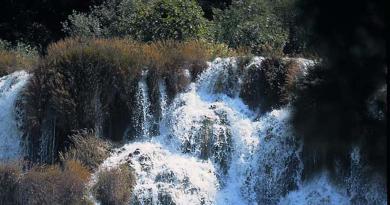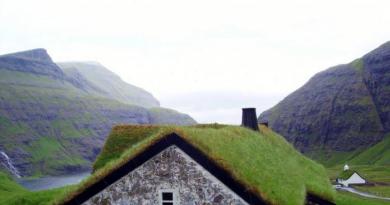So-called "alien" places on Earth that seem to be Martian deserts, then lunar craters, quite a few. It is there that science fiction films are usually shot, and NASA stages unsurpassed hoaxes of flights to the Moon and Mars.
And yet, according to researchers, there is the most “alien” place on Earth, and this is the Danakil Depression, which is located in Ethiopia, in the very north of this African country.

In Danakil, three completely different extreme systems can be distinguished, which can easily be confused with other planets. For example, in one of them you will find an unearthly world of boiling liquid, and this is not just water with a temperature close to one hundred degrees Celsius, this environment is full of sulfur, various acids, and therefore is colored poisonous yellow.
The second system of the depression is colder - only forty degrees Celsius, but it is notable for the fact that it is oversaturated with various copper salts, giving this area a truly fantastic look. But the third system is a kind of mushroom world, however, these “mushrooms” are not living, they are of a completely different type, since they consist of iron salts.

The unique Danakil depression, according to the Spanish scientist Felipe Gomz, is a completely unexplored territory unknown to people. Its beautiful, albeit harsh world is located one hundred meters below sea level, and therefore water constantly rushes here, but passing through heated lava rocks, it is enriched with all kinds of inorganics, turning into a kind of “chemical soup”. Such ecosystems, the researcher says, existed during the birth of our Earth. That is why they so easily imitate extraterrestrial conditions to this day...
However, the Danakil Desert is not so beautiful as it is dangerous for humans, including from the still wild African peoples living next to it. And yet, there are many hunters who want to get here, who are not afraid of any obstacles or dangers. However, this is really simpler and, of course, safer than going to, say, Mars or Venus...
In the northwestern part Indian Ocean Socotra Island is located 220 miles from the Yemen mainland. Socotra is known for its unique flora and fauna: in fact, 30% of the island's plants, such as the borage tree and cinnabar dracaena, cannot be found anywhere else in the world. It is for this reason that Socotra Island is included in the UNESCO World Heritage List.
On the island of Socotra (and by the way, Socotra is translated as “island of happiness”) you can see extremely rare representatives flora. In this remote corner of the globe, about 800 rare plants have found refuge, many of which are found nowhere else in the world. All these fantastic views are located 350 kilometers from the Arabian Peninsula.
Thanks to its extraordinary and exotic landscapes, Socotra has been dubbed “the most alien place on earth.” Once upon a time, many millions of years ago, this island was part of the African continent, but about six million years ago it separated from the mainland.
The island is part of Yemen and is part of the Socotra archipelago of the same name, consisting of three inhabited and one desert island. The “unusual” nature of Socotra is explained, for the most part, by the unique tropical desert and semi-desert climate, which is characterized by an average air temperature of 28.4 ° C and an almost complete absence of rain. In addition, due to its remoteness from the mainland, nature here developed and transformed in isolation for a very long time, which also contributed to the emergence of new unique species of flora and fauna.
The island's landscape is predominantly composed of sandy beaches, limestone caves, majestic mountains, and of course, unusual exotic plants. Many of the species found in Socotra are native to the island. Flora and fauna have developed here for millions of years without the intervention of civilization and in accordance with complex climatic conditions. In 2008, Socotra was included in the list of objects World Heritage UNESCO.
According to the results of botanical field research carried out under the auspices of the Center for Middle Eastern Plants at the Royal botanical garden in Edinburgh, only Hawaii, the Galapagos Islands and New Caledonia boast more endemic flora than Socotra. In addition, scientists discovered that out of 825 plant species, 307 are absolutely unique and are not found anywhere else in the world. That is why the island has gained the reputation of a “botanical paradise”.
The nature here has retained its pristine quality, largely due to the absence of civilization. For example, despite the fact that the population of Socotra is about 44 thousand people, the first roads appeared on the island only about 5 years ago.
Socotra is the home of the famous Dragon's Blood Tree, or Dracaena vermilion. This is an ancient plant, the tree resin of which is still used to prepare medicines. According to an ancient legend, once on the island there lived an evil and merciless dragon who drank the blood of elephants. Once a very strong elephant did not succumb to the dragon, and a fight began between them.
As a result, the blood of the elephant and the dragon mixed and spilled onto the ground. In these places, bizarre trees grew, which were called “dracaenas” (translated as “female dragon”). from the resin of Dracaena vermilion In addition, Socotra is famous for the magnificent and amazing flower “Desert Rose”.
It has a powerful “stem” that looks like an elephant’s foot, the top of which is decorated with the most delicate pink flowers. Also growing here is Dorsthenia gigantea and the Cucumber tree, which can only be seen on this island. According to the classification of plants, the cucumber tree belongs to the pumpkin family.
It has a very thick and fleshy trunk, which can reach 1 meter in diameter, and disproportionately small and short branches that make up a sparse crown.
The tree got its name from its fruits, which resemble cucumbers in appearance, but are covered with many thorns.
Socotra is home not only to exotic plants, but also to equally exotic fauna. For example, all the local mollusks, as well as 90% of all reptiles, are endemic, that is, unique, found only on this island.
Up to 140 species of birds also live here. Moreover, 10 of them can be found exclusively in Socotra, and nowhere else. Unfortunately, in Lately due to increased human interest in this amazing island, many plants and animals have sharply reduced their numbers, and some of them are even in danger of extinction.
Tourist interest in Socotra is only growing, and every year it unique place is becoming more and more urbanized, losing all the charm of pristine nature untouched by man.







An international group of scientists has named the most “unearthly” place on the planet - the Danakil Depression in northern Ethiopia.
Experts say the landscape and ecosystem of this unique point on Earth can provide insight into living conditions on other planets. Recently, a group of researchers began studying this area. Its leader, Felipe Gomez from the Astrobiological Center of Spain in Madrid, named Danakil the most dangerous place Earth.
The depression has not been studied at all by experts due to chlorine vapors that constantly escape from the soil. This heavy gas, deadly to humans, turns dry soil and rocks into unusual colors.
Three extreme ecosystems have been discovered in the alien “oasis”. The first is almost boiling water, its temperature exceeds 90 degrees Celsius. It is colored bright yellow due to the abundance of sulfur and acids. The second environment contains a lot of copper salts, its temperature is 40 degrees. The third environment resembles a “forest” of mushrooms, but they are non-living because they consist of iron salts.
The Danakil Depression is uncharted territory for us,” said Felipe Gomez. - Temperatures here reach 42 degrees during the day and 30 degrees at night. Plus, our lungs here constantly “burn” chlorine vapors. Any microorganisms that live here will be extremely interesting to astrobiologists.
The scientist claims that similar incredibly beautiful, but harsh ecosystems existed on Earth at the time of the origin of life. The “alien world” in the depression is located 100 meters below sea level.
Astrobiologists reported that they are completing a chemical analysis of Danakil. After this, experts will begin to study the microbes living in the waters and rocks of the depression.



Guys, we put our soul into the site. Thank you for that
that you are discovering this beauty. Thanks for the inspiration and goosebumps.
Join us on Facebook And In contact with
Our planet is a real storehouse of surprises. We think we know everything about it, but sometimes we come across places where, when we get there, it’s hard to believe that this is the same planet.
website invites you to travel to different parts of the Earth, where everything looks so unusual that it seems as if we have left the confines of our cosmic home.
16. Hidden Beach, Marieta Islands, Mexico
15. Lassen Volcanic National Park, USA
Besides alien landscapes national park Lassen Volcano, located in California, is famous for the fact that it is the only place on Earth where there are all 4 types of volcanoes: stratovolcano, shield volcano, as well as lava and cinder cones.
14. Mount Roraima, Brazil - Venezuela - Guyana
At first glance, it may seem that in front of us is a piece of land floating freely among the clouds. In fact, this is Mount Roraima, or, as it is also called, Table Mountain. The cloud near its top never disappears, and many species of plants can only be found in the vicinity of this mountain and nowhere else.
13. Zhangye Danxia National Geopark, China
These colorful mountain “layer cakes” are the result of sandstone and other rocks layered on top of each other over 24 million years. Winds and rains over millions of years have given these mountains a variety of shapes - from rounded to cone-shaped.
12. Salar de Uyuni, Bolivia
The dry salt lake of Uyuni stores 10 billion tons of salt. Every year during the rainy season, Uyuni is covered with a thin layer of water and turns into the world's largest natural mirror, which is used to calibrate satellites.
11. Salvador Dali Desert, Bolivia
A lifeless desert spread over an area of more than 100 square meters. km, as if she had stepped out of the paintings of a famous genius. Smooth mountains as if painted with watercolors, strange stones resembling trees growing out of nowhere, and endless sand - it seems that this is where Dali wrote his surreal masterpieces.
10. Danakil Depression, Ethiopia
The Danakil Depression is a place that can be considered the cradle of humanity, because it was here that the remains of Lucy, the first hominid known to science, were found. Thanks to the sulfur lakes, which are home to unique microorganisms that have adapted to extreme conditions, the local landscape resembles the views of Io, one of the moons of Jupiter.
9. Wave Gallery, Arizona, USA
“Wave” is a natural gallery formed from sandstone. 200 million years ago there were sand dunes here, which, under the influence of time and natural phenomena, turned the local landscape into an alien one. Getting here is not easy - local authorities issue no more than 20 vouchers per day, which also need to be won in a lottery.
8. Valley of the Moon, Atacama Desert, Chile
The Valley of the Moon is located in one of the driest places on the planet - the Atacama Desert. The landscape of the valley is very similar to the lunar one, because even the local lakes consist exclusively of a salt crust, and stone cliffs here and there they rise above the surface.
7. Flying Geyser, Nevada, USA
The Fly geothermal spring was formed due to human intervention: an error was made during the construction of the well, as a result of which boiling water came out. The minerals contained in it formed a “volcano” 1.5 meters high, which continues to increase in size.
6. Prohodna Cave, Bulgaria
Prohodna Cave, or “Eyes of God” - one of the most popular tourist places Bulgaria. The through holes in the rock are surprisingly symmetrical and really look like eyes, especially during rain, when water begins to flow through them, resembling tears.
5. Crooked Forest, Pomerania, Poland
Almost 400 pine trees, whose trunk sharply bends strictly in the north direction a few tens of centimeters from the ground, grow in one of
Cosmobiologists considered the Danakil Depression, which is located in Ethiopia, to be the most “alien” place on Earth. An amazing and vibrant place is famous for the presence of three unique ecosystems, looking at which only their alien origin comes to mind. As informs, astrobiologists are very interested in studying such distinctive ecological systems in northern Ethiopia.
The most “alien” place on Earth is the Danakil depression, cosmobiologists from the European scientific center Europlanet. Astrobiologist Felipe Gomez from the Madrid Center for Astrobiology (Centro de Astrobiologia) is the scientific director of the expedition to study the Danakil Depression. Scientists are keenly interested in the coexistence of unique ecosystems in this place of the planet, since microorganisms living in such extreme natural conditions, can serve science well.
In the “alien” Danakil Depression in northern Ethiopia, scientists have found three radically different natural ecosystems. One contains almost boiling bright yellow water at 90ºC, in which acids and sulfur are dissolved. In the second ecosystem, the water is cooler, only 40ºС, it is rich in copper salts and is colored turquoise. The third system from Danakil is a forest of mushrooms that nature created from iron salts. There is no other similar eco-richness on Earth; only the “alien” depression in Ethiopia can boast such a unique combination of ecosystems.
Studying the DNA of microorganisms in the “alien” cavity
Cosmobiologists intend to study the “alien” place as deeply as possible. “The Danakil Depression is almost unknown to science; there are literally several scientific works about it. This is still uncharted territory for us.” Hot temperatures (30ºC at night and 42ºC during the day) are a severe test even for Spanish scientists accustomed to the heat. In addition, the depression is located 100 m below sea level, so water needs to pass through rocks heated by volcanic lava to get to Danakil. After such enrichment, the water is given a unique “alien” chemical composition. During the expedition, scientists took samples of water and soil, as well as microorganisms to determine their DNA.
Places untouched by human activity are a real discovery for chemists, physicists and astrobiologists. By unraveling the secret of survival of the unique cultures and bacteria living in the Ethiopian Danakil, scientists may come to revolutionary discoveries in the field of biology and chemistry.



